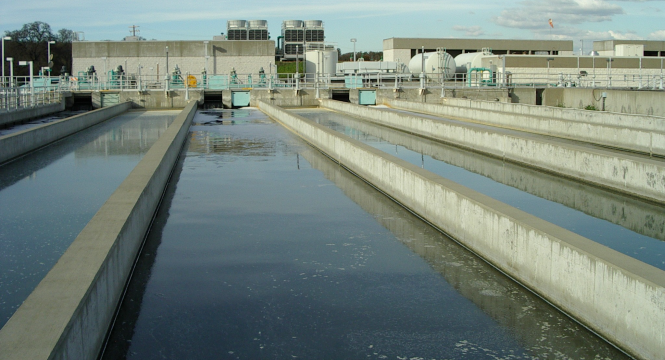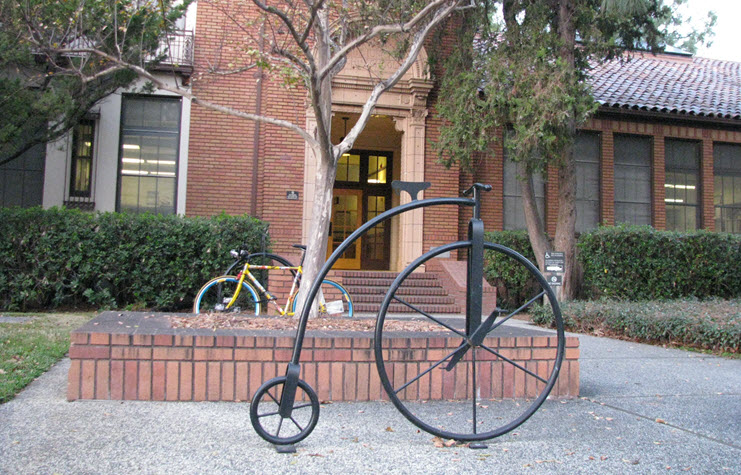 Last December the city of Davis was already set to move ahead with their wastewater treatment plan when, they were approached by the city of Woodland with an offer to spend half a million dollars to study a regional wastewater treatment project.
Last December the city of Davis was already set to move ahead with their wastewater treatment plan when, they were approached by the city of Woodland with an offer to spend half a million dollars to study a regional wastewater treatment project.
The council would reject that approach but considered another one in February. The plan would call for the piping of Davis’ wastewater to Woodland where Woodland’s existing plant capacity would be expanded. That proposal, city staff believes, could save about $30 million over the currently proposed project that would cost around $95 million.
Last month, Councilmember Lucas Frerichs, expressing concerns about governance with Woodland as well as harm to the city’s wetlands, made a motion to eliminate the regional option altogether.
Mayor Joe Krovoza fought to keep the option on the table, citing the possibility of saving $30 million.
The decision was held over until this week. The staff report this week gives the council two options.
First, they can identify the local alternative as the preferred alternative and staff would continue to develop the design-build procurement documents, maintaining the pace to meet a 2017 deadline, while at the same time re-bidding the rehabilitation and replacement project.
The second option would be to direct “the City Manager to conduct a more thorough analysis of the Regional Alternative and adopt the attached resolution authorizing the City Manager to award consultant contracts to facilitate the regional alternative analysis in a not-to-exceed amount of $220,000.”
The staff report then goes through and analyzes the advantages and disadvantage for both approaches. They identify three major criteria, two of which favor the local approach, but the one that favors the regional approach is the cost.
Staff argues that “Certainty of compliance with regulatory requirements within the prescribed timeline (as defined by our NPDES permit): Davis must either cease discharge, or meet effluent requirements by 2017,” favors the local approach, as it has already begun the process and received approvals from the Regional Water Quality Control Board.
Staff writes, “The Local alternative has been understood and acceptable to our ratepayers. Deviation from our current path is likely to require extensive analysis and discussion, potentially resulting in significant delays, i.e.”
“Once a more rigorous analysis of the Regional alternative is completed, it is unknown how long will be required for the community to choose between the Regional and Local alternatives,” they write.
Given the acrimony involved in the regional water supply project, staff is understandably hesitant about re-opening the genie.
Staff has concerns, though, about the timeline, as well, arguing, “Delays will likely force the City to conduct planning, design, and construction efforts under a condensed timeframe. Forcing those efforts to be conducted quickly will limit the City’s options and could end in less-than optimal outcomes which may lead to increased costs.”
The City of Davis has completed CEQA processing for most portions of the Local Alternative, and the Regional Alternative will likely require a new EIR. In addition, there would need to be additional permitting for a regional facility.
On the other hand, staff argues that the Net Present Value (NPV) in terms of the capital and operations costs over the next 30 years, favors the regional approach.
“The NPV is lower for the Regional Alternative. The NPV for the Local Alternative is about $284M. The NPV for the Regional Alternative is likely between 5% and 12% lower than the Local Alternative (a reduction of $11M to $30M over the 30-yr period),” staff writes. “The rate difference between alternatives will depend upon financing decisions, but is likely to be about $3 per month for the average residential customer initially, with the potential for this to gradually increase over time.”
Governance, however, favors the local approach where, under the local alternative, “total control remains in Davis. The City has an established and successful wastewater management program in place.”
“Regional governance is unknown,” staff writes. “It is possible that the Regional alternative could be part of the Woodland-Davis Clean Water Agency JPA. There would be the need to develop common understanding of wastewater priorities, including costs, environmental stewardship sensitivities, and growth expectations. Future decisions may require balancing between best interests of two communities.”
What is odd about this argument is that it is very similar to the one that opponents of the surface water project used to argue against the JPA structure, and now the city is advancing it as a reason to potentially oppose the regional option.
In terms of the six minor criteria, four of the seven favor the local approach, including facility reliability, wetlands, location and the city’s wastewater collection system.
Staff argues that the Davis alternative would be constructed to fit Davis’ current and future needs, while the regional approach would involve significant modifications to an existing facility.
There are concerns about the wetlands, with staff arguing, “It is likely that treated effluent will continue to be used for wetlands operations. Treated effluent for the wetlands from the Regional alternative will only be available if a treated effluent pipeline was constructed back to the Davis site (about $10M cost).”
They add, “It is possible that treated effluent will no longer be allowed to be used for wetlands operations because of regulatory issues. In that case, there is no difference between the alternatives.”
Location is also an advantage, as the Davis one would be in an area protected from encroachment by urban uses while the Woodland facility is near residential and commercial development, with potential community issues regarding odors or constraints on plant operations.
On the other hand, there would be an advantage for future regulatory required capital improvements with the regional option. Writes staff, “If additional treatment processes are required, such as the removal of endocrine disruptors, it is likely to be less expensive at a regional facility (because of economies of scale) than at two separate facilities. There is great uncertainty of the future requirements and necessary improvements – hence this is considered a minor criteria.”
In addition, they see better opportunities for urban and industrial water re-use near the Woodland Facility. But they add, “The Regional alternative would effectively eliminate the possibility of re-use opportunities within the City of Davis unless a treated effluent pipeline was constructed back to the City limits (about $10M cost).”
A February 3, 2013, letter from Woodland City Manager Paul Navazio to his Davis counterpart, noted that he understands that “City of Davis staff has worked diligently to advance the local ‘charrette’ alternative, as described in the two-phased project plan leading toward award of a design-build contract for an upgraded City of Davis Wastewater treatment plant that would satisfy your operational and regulatory requirements by 2017.”
He writes, “The City of Woodland is interested in working with the City of Davis to expeditiously advance a more detailed analysis of a revised and improved regional partnership concept, while also ensuring that Davis remains on track to meet its current timeframe for addressing wastewater regulatory permit requirements.”
The original analysis had Davis saving around $7 million in a regional approach. Naturally, given that relatively small level of savings, Davis saw clear advantages in continuing on its own path.
However, things have now changed.
Writes Mr. Navazio, “The City of Woodland has presented a conceptual proposal to Davis staff that we believe could conservatively yield upwards of $47 million in net-present value savings to Davis over a 30-year period.”
“This compares to the $7 million savings estimated in the 2010 analysis; Davis staff has reviewed the Woodland proposal – under alternative assumptions – and has characterized the potential savings to be in the range of $19 – $39 million,” he continues. “While this represents a more conservative estimate than Woodland’s, it nonetheless represents a significant improvement from the 2010 analysis, and thus warrants additional consideration.”
He also notes that Woodland can address some of the “minor” concerns, as well.
Woodland is willing to participate in the proposed study as a full partner, however, he notes, “Our participation is predicated on an understanding that we would be collaborating to undertake an objective, independent evaluation, as well as agreement on consultants to be engaged, scope of review, and baseline assumptions.”
He notes that Woodland assumes that Davis is committed to that independent analysis, but noted “Woodland would have some level of reservation about providing 50% funding support. In other words, “If the study confirms that there are significant benefits to Davis, is the City prepared to commit to pursuit of a regional project alternative?”
According to staff, “The City of Woodland has offered to share in some portion of the cost of the investigation pending agreement on the scope of work and consultant selection. The magnitude of their contribution would be determined based on the scope of work to be accomplished by the consultant(s).”
Staff concludes, “Regardless of the amount Woodland may contribute, there are sufficient City funds budgeted in this fiscal year’s project budget to fund the proposed effort for the Regional Investigation.”
—David M. Greenwald reporting






Which project is more likely to exceed its budget? Would seem it might be the regional one since it has not been studied as extensively?
It is ironic that the staff is presenting arguments against the regional project which, for the the water project, were made by the NO on I folks! And this is the plant that is across the street from the water plant?
“Last month, Councilmember Lucas Frerich, expressing concerns about governance with Woodland….”
Has he picked up the Michael Harrington refrain?
[quote]
SODA
03/26/13 – 07:33 AM
…
Which project is more likely to exceed its budget?
[/quote]
The answer to that is [b]both of them[/b].
This decision comes down to money and politics . . . no surprise.
The money seems to very clearly favor the regional approach. Whether it is the “$11M to $30M” savings that Davis staff cites or the $47 million that Paul Navazio notes in his letter, the savings is substantial. You can also assume that Woodland is going to see substantial savings from their current annual wastewater expenses. So this is a $50 million to $100 million decision IMHO. Not trivial.
The politics is the sticking point. We have heard clear indications from the dais in the past discussions that Davis’ political leaders feel that the governance of a regional facility should be weighted toward davis regardless of the plant location. It is hard to argue with that political logic. On the other hand it is easy to see why Bill Marble and Skip Davies may see a political downside for Woodland in that approach. Imagine Bill and/or Skip walking down Main Street with Woodland citizens flocking to them asking the following politically charged question, [i]”Davis puts us through all the water agony they did over the past 18 months, and you grant them control of our wastewater plant! What were you thinking?! Woodland taxpayers paid for that plant! Its location is in the Woodland City Limits! Why should it have governance that is controlled by Woodland?!”[/i]
If I were Bill or Skip in that situation, my answer would be, [i]”Because it saves the Woodland taxpayers over $1 million per year.” [/i] I might even add, [i]”And given our current budgetary situation, we need all the savings we can get!”[/i]
The problem with that answer is that it can be seen as political dynamite.
So I expect that politics will trump savings both in Woodland, where their Council will not be willing to agree to a governance structure with Davis in control, and in Davis, where our Council will not be willing to pursue wastewater regionalization without a governance structure with Davis in control.
[quote]Staff argues that “Certainty of compliance with regulatory requirements within the prescribed timeline (as defined by our NPDES permit): Davis must either cease discharge, or meet effluent requirements by 2017,”
They add, “It is possible that treated effluent will no longer be allowed to be used for wetlands operations because of regulatory issues. In that case, there is no difference between the alternatives.”[/quote]
One of major selling points for the river water project was that is will solve the high salt content of our current waste water that is discharged into the wetlands, and that failure to fix this high salt discharge problem would result in large fines. So was the high salt content never an issue, or will the river water project do nothing to solve this problem, or is there some other problem with the discharged water?
I generally have no fear of partnerships to solve community challenges. Many of the advances we have made as a community these past few difficult years have been in partnership with our neighboring communities, with UC Davis, with public/private partnerships, or with inter-organizational partnerships (faith-based, non-profit, for profit, individual, etc.). With resources so scarce and community challenges ever increasing, it is incumbent upon us to generate the biggest feasible return on our investments. Exploring this opportunity with Woodland is money well spent if it leads to many millions in savings. That said, partnerships are all about agreements and the agreement details. If a favorable agreement with Woodland can be reached, great; if not, so be it.
-Michael Bisch
I agree 100% with DTB. Maybe the first step is for Davis officials and Davis residents to get a formal, professional makeover into something a bit more attractive to our surrounding neighbors. Our image as a friendly, reliable and trustworthy partner is currently about as low as I ever remember it being.
There is so much irony in this expressed concern from Councilmember Frerichs. The irony is that Davis – with its 80% population of liberals… the political ideology that likes to wear their “cooperation over competition” button proudly on their lapel – has developed a reputation as being anything but cooperative.
As DTB points out, we cannot afford to not seek the lower-cost solutions. We have to be cooperative. There is also a more macro ethical consideration as two communities can save significant money by joining in partnership for a wastewater solution.
When I consider that Davis and Woodland, or Davis and West Sacramento cannot even get along well enough to partner on public works infrastructure projects, is it a surprise that democracy is not working in all the tribal countries in the Middle East? I used to think that it was just the lack of education keeping all the Arab and Persian people from getting along. However, it appears that greater education just changes the tribal weapon from sword to words. If we cannot generate enough trust to form an effective process of governance for a wastewater treatment plant, then hope for cooperation in general would appear to be a lost cause.
why is this an issue on wastewater but wasn’t on surface water?
I think of this the same way I thought of the idea of getting our water from West Sac: It would be stupid to not consider the proposition.